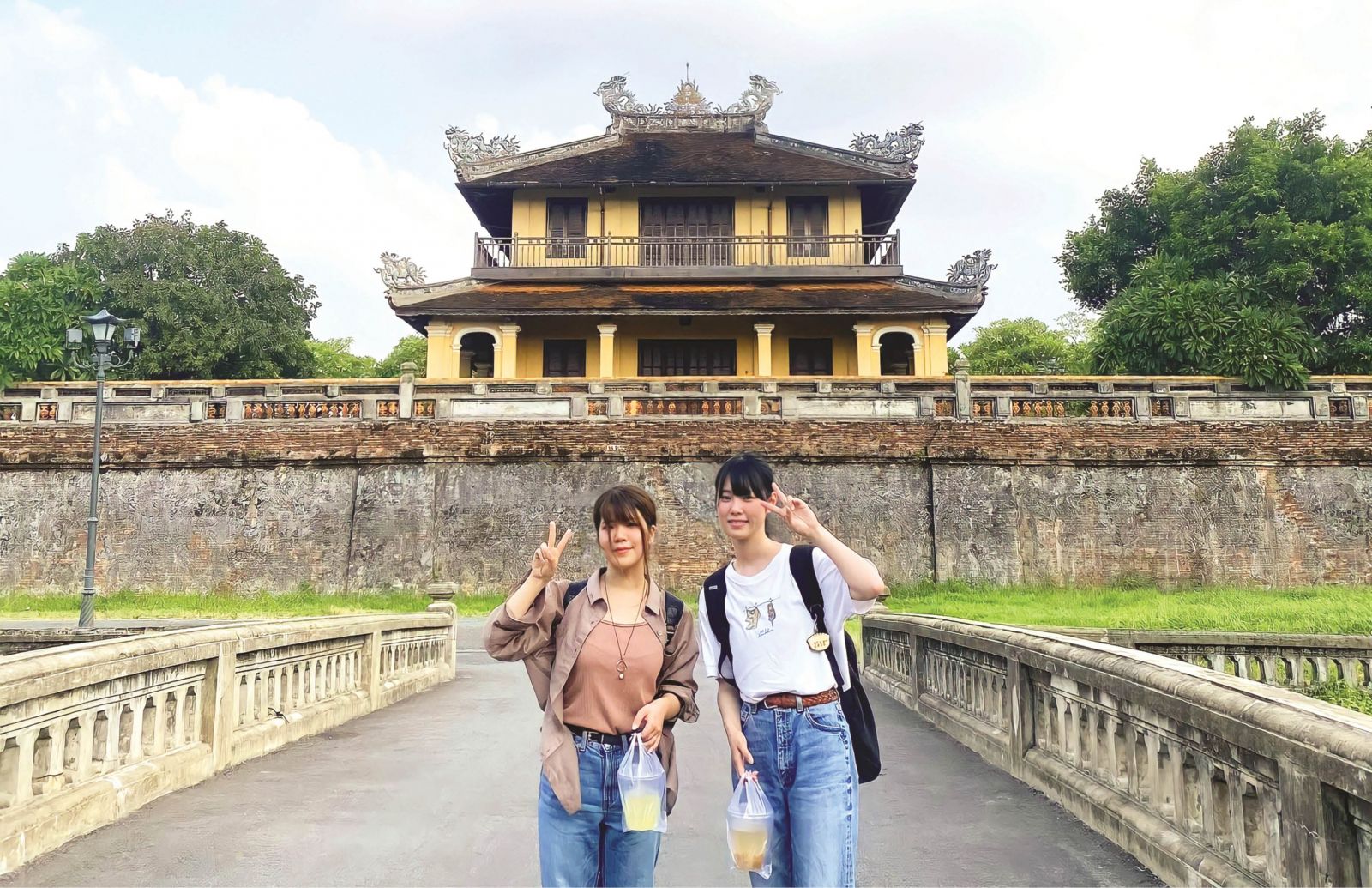
Checking-in at Hoa Binh gate
Fascinated by Hue culture
On the days of changing seasons, I had the opportunity to follow a group of students from Seika University (Kyoto, Japan) during an exchange between Seika University and the Faculty of Architecture, University of Sciences, Hue University. On this occasion, the students from Japan had the opportunity to experience the cuisine and culture of the ancient capital.
The first morning in Hue, friends from far away came to visit An Hien garden house. The entrance to the garden house is a small brick archway. Along the path are two rows of white plum trees intertwined, shading the whole area. On the left is a rectangular lake completely covered with water lilies and lotus flowers.
Japanese friends cannot help but admire and enjoy the poetic, peaceful, and ancient scenery of the garden house with delicately carved motifs and patterns. As a student majoring in fine arts, Sana Koyama proved quite knowledgeable about garden architecture.
“I have researched and learned that the garden house is a typical architectural form of Hue. It has both an aristocratic appearance and traditional folk colors. Although I have seen a lot of pictures on the internet, I still feel very interested and impressed by the architecture of Hue garden houses," said Sana. She kept saying "great" in Japanese.

Experiencing rowing SUP at Tam Giang lagoon
In the afternoon, they experienced yachting, rowed paddle boards sup, played team building games as well as enjoyed food at Ngu My Thanh mural village and Tam Giang - Cau Hai lagoon. The friendliness and sociability of the Vietnamese students made Misaki and Japanese students more engaged. Although there were language barriers when not everyone spoke English well, with the help of "sister Google", the student groups of the two schools still communicated comfortably.
“I am very impressed with Hue cuisine. Your fish sauce is very delicious. Although we Japanese do not eat spicy food like Hue people, but the rich flavor is very suitable for seafood dishes, especially squid," said Tatsuya Imizu, a male student of Seika University.
After the first day of experience, students from the two schools were divided into small groups to conduct surveys, research, and develop ideas for the development of the Imperial Citadel pedestrian street within three days. Japanese students had the opportunity to visit the pedestrian street of the Citadel at night as well as visit the Imperial Citadel.
Coming to the Imperial Citadel for the first time, Sana was overwhelmed by the magnificent beauty and unique architecture of this place. With the "dual house" architecture, that is, the house connects the house, the roof connects the roof, ironwood was used to build, the roof, pillars, walls, etc., are all sculpted in the shape of a winding dragon; Thai Hoa Palace appears with majesty and is the place where high court meetings between kings and courtiers took place. And it is impossible not to mention Truong Sanh Palace, Dien Tho Palace, Co Ha Garden, and other architectures.
During the day, it has an ancient beauty, and when night falls, the Imperial Citadel appears with a shimmering and fanciful look that makes Sana extremely excited. The female student opened her eyes when visiting Hue Citadel. Visiting the Imperial Citadel, she and her friends went from surprise to surprise.
Visiting and listening to explanations from the guides helped Sana and her friends imagine the life of the ancient Vietnamese kings, understand how the ancients worked and protected the country, as well as understand more concepts of the ancients about nature and people.
Coming to Hue at the time of season change, friends from Japan also experienced the "specialty" of Hue rain. “On sunny days, Hue appears to be a dynamic city, not too bustling like Ho Chi Minh City but also has a modern appearance. However, when it rains, Hue has a deep look, through the rain, the walls and the once majestic mausoleums become even mossier. The rain also gives Hue a range of cold, deep color that echoes from the small streets, low houses, quiet trees, and quiet footsteps. Seeing the landscape and people here change with the weather is really exciting for us art and architecture students,” said Tatsuya excitedly.
Beautiful memories
During the days of staying in the ancient capital, Japanese students felt the friendliness and cheerfulness of Vietnamese students.
“They took us to visit scenic spots such as the Imperial Citadel, Thien Mu Pagoda, Ho Chi Minh Museum. But what I remember most was the first time eating Hue sweet soup. As a person who has a sweet tooth, when I was taken to enjoy sweet soup, I was attracted by the colorful pots of sweet soup at a street vendor near the Imperial Citadel. That day, Che Bot Loc Thit Quay was introduced as a specialty that only Hue has, which made me say: extremely delicious. The sweetness of the sugar water, the slightly salty taste of the roast pork, and the chewiness of the dough make me remember it forever," Sana confided.
On the day of farewell, Hue students went to the airport to see their foreign friends off. They gave each other gifts and added friends on social networks so they could still follow each other.
“This trip is really meaningful to me; we not only know more about the culture and people of your country, but also have more friends. Although we do not share the same language, we have the same passion for art, architecture, and painting. I will come back to Vietnam to visit you again,” said Tatsuya, then said goodbye to us to enter the airport with a bright smile.
Story and photos: Dang Trinh